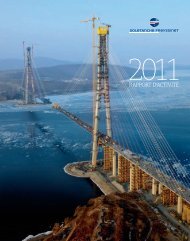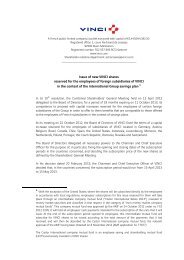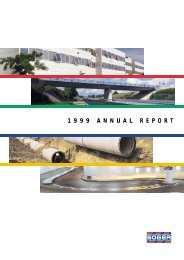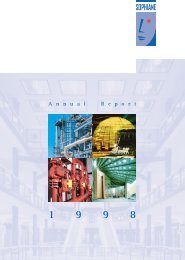CFE - 2006 annual report - Vinci
CFE - 2006 annual report - Vinci
CFE - 2006 annual report - Vinci
- TAGS
- annual
- vinci
- publi.vinci.com
You also want an ePaper? Increase the reach of your titles
YUMPU automatically turns print PDFs into web optimized ePapers that Google loves.
) Defined benefit plans<br />
For defined benefit plans, the pension accounting costs are assessed separately for each plan using the projected unit credit<br />
method. The projected unit credit method considers each period of service as giving rise to an additional unit of benefit entitlement<br />
and measures each unit separately.<br />
Under this method, the cost of providing pensions is charged to the income statement so as to spread the regular cost over the<br />
service lives of employees in accordance with the advice of qualified actuaries who carry out a full valuation of the plans at least<br />
every three years. The amounts charged to the income statement consist of current service cost, interest cost, the expected return<br />
on any plan assets, actuarial gains or losses and past service costs.<br />
The pension obligations recognized in the balance sheet are measured as the present value of the estimated future cash outflows<br />
using interest rates of high quality corporate bonds, which have terms to maturity approximating the terms of the related liability,<br />
adjusted for the unrecognised actuarial gains and losses and less any past service costs not yet recognized and the fair value of<br />
any plan assets.<br />
The recognition of actuarial gains and losses is determined separately for each defined benefit plan. Actuarial gains and losses<br />
comprise the effects of differences between the previous actuarial assumptions and what has actually occurred and the effects of<br />
changes in actuarial assumptions.<br />
All actuarial gains and losses exceeding a corridor of 10% of the higher of the fair value of plan assets and the present value of the<br />
defined benefit obligations are recognized in the income statement over the average remaining service lives of employees partici-<br />
pating in the plan. Otherwise, the actuarial gain or loss is not recognized.<br />
Past service costs are recognized as an expense over the average period until the benefits become vested, unless they are already<br />
vested following the introduction of or changes to a defined benefit plan, in which case the past service costs are recognized as an<br />
expense immediately.<br />
Where the calculation results in a benefit to the company, the recognized asset is limited to the net total of any unrecognised<br />
actuarial losses and past service costs and the present value of any future refunds from the plan or reductions in future contribu-<br />
tions to the plan.<br />
The expected charges of these benefits are written-off during the active career of the employee by applying similar accounting<br />
methods as the one’s used for defined benefits plan. Independents qualified actuaries realize the calculation of these obligations.<br />
2. Bonus<br />
Bonuses received by company employees and management is based on financial key indicators. The estimated amount of the<br />
bonus is recognized as an expense in the year.<br />
S. Interest-bearing borrowings<br />
Interest-bearing borrowings are recognized initially at cost, less attributable transaction costs. Any difference between<br />
this net value and the redemption value is recognized in the income statement over the period of borrowings on an effective<br />
interest rate basis.<br />
1 2 3
















